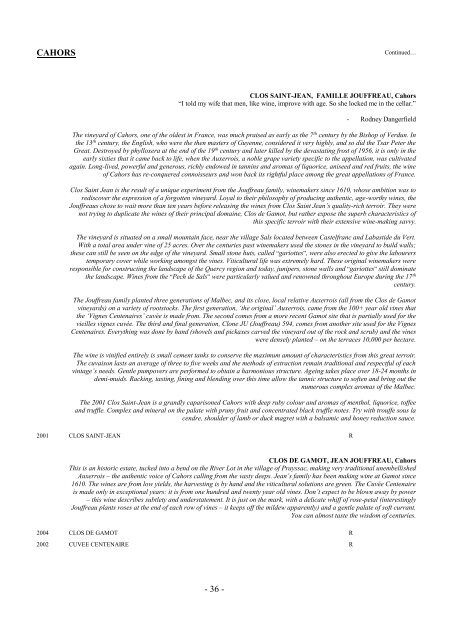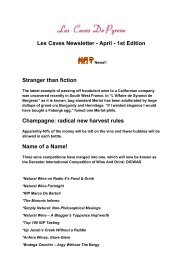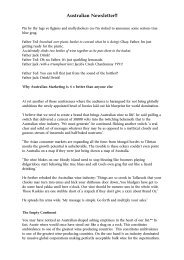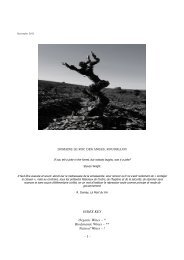Download our list here - Les Caves de Pyrene
Download our list here - Les Caves de Pyrene
Download our list here - Les Caves de Pyrene
You also want an ePaper? Increase the reach of your titles
YUMPU automatically turns print PDFs into web optimized ePapers that Google loves.
CAHORSContinued…CLOS SAINT-JEAN, FAMILLE JOUFFREAU, Cahors“I told my wife that men, like wine, improve with age. So she locked me in the cellar.”- Rodney DangerfieldThe vineyard of Cahors, one of the ol<strong>de</strong>st in France, was much praised as early as the 7 th century by the Bishop of Verdun. Inthe 13 th century, the English, who were the then masters of Guyenne, consi<strong>de</strong>red it very highly, and so did the Tsar Peter theGreat. Destroyed by phylloxera at the end of the 19 th century and later killed by the <strong>de</strong>vastating frost of 1956, it is only in theearly sixties that it came back to life, when the Auxerrois, a noble grape variety specific to the appellation, was cultivatedagain. Long-lived, powerful and generous, richly endowed in tannins and aromas of liquorice, aniseed and red fruits, the wineof Cahors has re-conquered connoisseurs and won back its rightful place among the great appellations of France.Clos Saint Jean is the result of a unique experiment from the Jouffreau family, winemakers since 1610, whose ambition was torediscover the expression of a forgotten vineyard. Loyal to their philosophy of producing authentic, age-worthy wines, theJouffreaus chose to wait more than ten years before releasing the wines from Clos Saint Jean’s quality-rich terroir. They werenot trying to duplicate the wines of their principal domaine, Clos <strong>de</strong> Gamot, but rather expose the superb characteristics ofthis specific terroir with their extensive wine-making savvy.The vineyard is situated on a small mountain face, near the village Sals located between Castelfranc and Labasti<strong>de</strong> du Vert.With a total area un<strong>de</strong>r vine of 25 acres. Over the centuries past winemakers used the stones in the vineyard to build walls;these can still be seen on the edge of the vineyard. Small stone huts, called “gariottes”, were also erected to give the lab<strong>our</strong>erstemporary cover while working amongst the vines. Viticultural life was extremely hard. These original winemakers wereresponsible for constructing the landscape of the Quercy region and today, junipers, stone walls and “gariottes” still dominatethe landscape. Wines from the “Pech <strong>de</strong> Sals” were particularly valued and renowned throughout Europe during the 17 thcentury.The Jouffreau family planted three generations of Malbec, and its close, local relative Auxerrois (all from the Clos <strong>de</strong> Gamotvineyards) on a variety of rootstocks. The first generation, ‘the original’ Auxerrois, came from the 100+ year old vines thatthe ‘Vignes Centenaires’ cuvée is ma<strong>de</strong> from. The second comes from a more recent Gamot site that is partially used for thevieilles vignes cuvée. The third and final generation, Clone JU (Jouffreau) 594, comes from another site used for the VignesCentenaires. Everything was done by hand (shovels and pickaxes carved the vineyard out of the rock and scrub) and the vineswere <strong>de</strong>nsely planted – on the terraces 10,000 per hectare.The wine is vinified entirely is small cement tanks to conserve the maximum amount of characteristics from this great terroir.The cuvaison lasts an average of three to five weeks and the methods of extraction remain traditional and respectful of eachvintage’s needs. Gentle pumpovers are performed to obtain a harmonious structure. Ageing takes place over 18-24 months in<strong>de</strong>mi-muids. Racking, tasting, fining and blending over this time allow the tannic structure to soften and bring out thenumerous complex aromas of the Malbec.The 2001 Clos Saint-Jean is a grandly caparisoned Cahors with <strong>de</strong>ep ruby col<strong>our</strong> and aromas of menthol, liquorice, toffeeand truffle. Complex and mineral on the palate with pruny fruit and concentrated black truffle notes. Try with trouffe sous lacendre, shoul<strong>de</strong>r of lamb or duck magret with a balsamic and honey reduction sauce.2001 CLOS SAINT-JEAN RCLOS DE GAMOT, JEAN JOUFFREAU, CahorsThis is an historic estate, tucked into a bend on the River Lot in the village of Prayssac, making very traditional unembellishedAuxerrois – the authentic voice of Cahors calling from the vasty <strong>de</strong>eps. Jean’s family has been making wine at Gamot since1610. The wines are from low yields, the harvesting is by hand and the viticultural solutions are green. The Cuvée Centenaireis ma<strong>de</strong> only in exceptional years: it is from one hundred and twenty year old vines. Don’t expect to be blown away by power– this wine <strong>de</strong>scribes subtlety and un<strong>de</strong>rstatement. It is just on the mark, with a <strong>de</strong>licate whiff of rose-petal (interestinglyJouffreau plants roses at the end of each row of vines – it keeps off the mil<strong>de</strong>w apparently) and a gentle palate of soft currant.You can almost taste the wisdom of centuries.2004 CLOS DE GAMOT R2002 CUVEE CENTENAIRE R- 36 -








